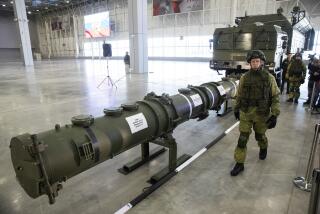Missile Defense Program Is Money Down the Drain
- Share via
President Clinton’s new budget proposes to spend $12 billion more for military programs in 2000 and $112 billion more in the next six years. Perhaps no single program provides a clearer, more powerful illustration of huge sums of money being wasted in this proposal than national missile defense to which he proposes to add $6.6 billion.
In Cold War language that is reminiscent of “bomber gaps,” “missile gaps” and “windows of vulnerability,” we are being told that it is necessary to prepare defenses against a handful of missile warheads fired at America by a rogue state or terrorist group. In truth, this is the least likely threat of attack on the United States.
First, the development of reliable intercontinental range ballistic missiles was a daunting task even for the U.S. and cost hundreds of billions of dollars after prolonged testing marked by repeated failures. It is highly unlikely a rogue state or terrorist group could develop such a missile.
Added to that, the rogue state-terrorist group must fit the missile with compatible, reliable and effective warheads. Try as they might, not one such putative adversary has even remotely approached that level of technology. And even if they had created such a device, there is the fact that America’s borders are open to penetration at much less cost and risk. Even a crude nuclear device totally unsuitable for missile delivery could be secreted in the hull of a merchant ship on shipping containers and arrive undetected at countless harbors and transportation centers throughout the U.S. The same is true for biological and chemical agents. Unlike ballistic missiles that carry a return address that guarantees swift, devastating retaliation, weapons delivered by clandestine means make effective retaliation much more difficult, if not impossible.
There also still remains the fact that after more than 15 years of trying, missile defense systems remain far from a proved means of “hitting a bullet” in space, as Lt. Gen. Lester Lyles, head of the Ballistic Missile Defense Office, describes the problem. Despite spending more than $55 billion on the effort, the last five attempts using the most advanced defensive system failed even though the target was much less demanding than a true intercontinental range missile.
There is yet another reason to question the wisdom of throwing more money at national missile defense: As presently conceived, the system would be a clear violation of the U.S.-Russia Anti-Ballistic Missile Treaty of 1972. This treaty has been the solid foundation of all arms control efforts for the past 27 years. If we violate it, in spite of strong Russian objections, we virtually assure not only the end of arms reduction efforts but we jeopardize the very positive progress of the U.S.-Russia Cooperative Threat Reduction program. Funded by Congress through the Nunn-Lugar Act, it is our best hope to deal with the “loose nuke” problem in Russia.
In terms of real security, dollar for dollar we would achieve more safety by canceling the national missile defense program and devoting the funds directly to the accelerated dismantlement of Russian weapons, improving the security and accountability of their fissile material stockpile and proceeding with mutual reductions of existing nuclear weapons arsenals. None of this will happen if we deploy a national missile defense system.
Russia is weak and defenseless today. We can ignore its concerns now, but in the years to come Russia will slowly recover and resume a great power role in the world. By rash actions such as abrogation of the anti-ballistic missile treaty we are far more likely to rekindle the Cold War with a hostile nation than to produce a constructive relationship with a cooperative Russia. Dollars and common sense both dictate forgoing an unneeded national missile defense system in favor of resolving the only real external danger we face through an accelerated threat reduction program with Russia.
More to Read
Sign up for Essential California
The most important California stories and recommendations in your inbox every morning.
You may occasionally receive promotional content from the Los Angeles Times.













